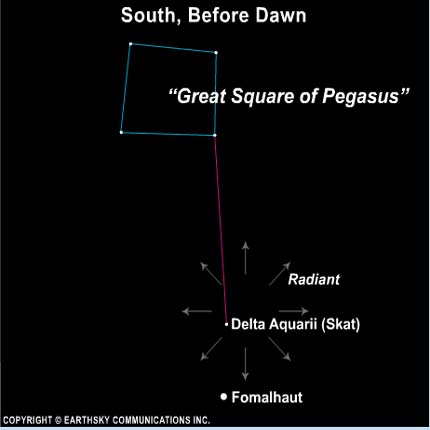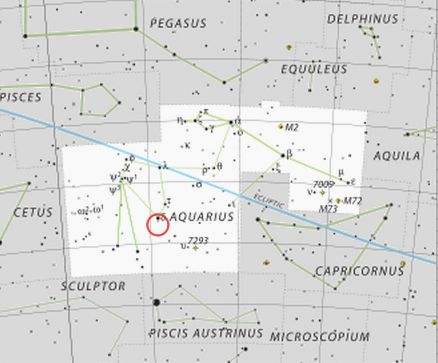The star Skat – near the radiant for the Delta Aquariids – is the 3rd-brightest in the faint constellation Aquarius.
The Delta Aquariid meteor shower has a broad maximum and produces meteors throughout late July and early August. It overlaps with the more famous Perseid meteor shower, which peaks this year on the mornings of August 12 and 13. The Delta Aquariid shower takes its name from the star Skat – also known by its Greek name Delta Aquarii. If you trace the paths of the meteors backward, you’ll find that all Delta Aquariids appear to originate from a point near this star. This point – near Skat – is called the radiant point of the Delta Aquariid meteor shower.
Skat isn’t a bright star. It ranks as only the third-brightest in the dim constellation Aquarius the Water Bearer. Still, you can glimpse this constellation and this star, if you go someplace nice and dark. If you’re in the Northern Hemisphere, you’ll also need a good view to the south. From mid-latitudes in the Southern Hemisphere, the star and constellation are northward and higher in the sky.
Skat or Delta Aquarii appears modestly bright in a dark country sky. It’s near on the sky’s dome to a very bright star, Fomalhaut in the constellation Piscis Austrinus the Southern Fish.
If you can see the Great Square of Pegasus and Fomalhaut, they can help you find Skat. See the chart below.

Find the star Skat by first finding the Great Square of Pegasus. Skat is found roughly on a line drawn southward through stars on Square’s west side. It’s between the Great Square and the bright star Fomalhaut.
Of course, in actuality, the Delta Aquarid meteors have nothing whatever to do with the star Skat. The meteors burn up some 60 miles (100 km) above Earth’s surface. Skat lies about 160 light-years away.
A meteor shower results when the Earth passes through the orbital path of a comet, and the debris from this passing comet vaporizes in the Earth’s upper atmosphere. The meteors enter Earth’s atmosphere on parallel paths.
Seeing them come from a radiant point in the sky is much the same illusion as standing on railroad tracks and seeing the tracks converge in the distance.
When you stand on a railroad track, you can see the illusion of tracks converging in the distance. Likewise, the paths of meteors in a single meteor shower appear to converge at a point – the radiant point – on the sky’s dome. Image via Shutterstock.
In late July and early August, when the Delta Aquariid meteors are flying, Skat and its constellation Aquarius rise above the horizon in the hours between midnight and dawn. They’re best seen in the evening sky in the months of October, November, and December.
No matter when you look, you’ll always find Skat to the south (or below) the Great Square of Pegasus and to the north (or above) the bright star Fomalhaut.

View larger. | Want to see the star Skat? This chart can help, and you also need a dark sky. Chart via Wikimedia Commons.
Bottom line: How to find the star Skat, or Delta Aquarii, third-brightest star in the constellation Aquarius the Water Bearer, radiant point for the Delta Aquariid meteor shower. Plus an explanation of why meteors in annual showers have radiant points.
Great Square of Pegasus: Easy to see
Read about all the major meteor showers: EarthSky’s meteor shower guide
from EarthSky https://ift.tt/1LHhysX
The star Skat – near the radiant for the Delta Aquariids – is the 3rd-brightest in the faint constellation Aquarius.
The Delta Aquariid meteor shower has a broad maximum and produces meteors throughout late July and early August. It overlaps with the more famous Perseid meteor shower, which peaks this year on the mornings of August 12 and 13. The Delta Aquariid shower takes its name from the star Skat – also known by its Greek name Delta Aquarii. If you trace the paths of the meteors backward, you’ll find that all Delta Aquariids appear to originate from a point near this star. This point – near Skat – is called the radiant point of the Delta Aquariid meteor shower.
Skat isn’t a bright star. It ranks as only the third-brightest in the dim constellation Aquarius the Water Bearer. Still, you can glimpse this constellation and this star, if you go someplace nice and dark. If you’re in the Northern Hemisphere, you’ll also need a good view to the south. From mid-latitudes in the Southern Hemisphere, the star and constellation are northward and higher in the sky.
Skat or Delta Aquarii appears modestly bright in a dark country sky. It’s near on the sky’s dome to a very bright star, Fomalhaut in the constellation Piscis Austrinus the Southern Fish.
If you can see the Great Square of Pegasus and Fomalhaut, they can help you find Skat. See the chart below.

Find the star Skat by first finding the Great Square of Pegasus. Skat is found roughly on a line drawn southward through stars on Square’s west side. It’s between the Great Square and the bright star Fomalhaut.
Of course, in actuality, the Delta Aquarid meteors have nothing whatever to do with the star Skat. The meteors burn up some 60 miles (100 km) above Earth’s surface. Skat lies about 160 light-years away.
A meteor shower results when the Earth passes through the orbital path of a comet, and the debris from this passing comet vaporizes in the Earth’s upper atmosphere. The meteors enter Earth’s atmosphere on parallel paths.
Seeing them come from a radiant point in the sky is much the same illusion as standing on railroad tracks and seeing the tracks converge in the distance.
When you stand on a railroad track, you can see the illusion of tracks converging in the distance. Likewise, the paths of meteors in a single meteor shower appear to converge at a point – the radiant point – on the sky’s dome. Image via Shutterstock.
In late July and early August, when the Delta Aquariid meteors are flying, Skat and its constellation Aquarius rise above the horizon in the hours between midnight and dawn. They’re best seen in the evening sky in the months of October, November, and December.
No matter when you look, you’ll always find Skat to the south (or below) the Great Square of Pegasus and to the north (or above) the bright star Fomalhaut.

View larger. | Want to see the star Skat? This chart can help, and you also need a dark sky. Chart via Wikimedia Commons.
Bottom line: How to find the star Skat, or Delta Aquarii, third-brightest star in the constellation Aquarius the Water Bearer, radiant point for the Delta Aquariid meteor shower. Plus an explanation of why meteors in annual showers have radiant points.
Great Square of Pegasus: Easy to see
Read about all the major meteor showers: EarthSky’s meteor shower guide
from EarthSky https://ift.tt/1LHhysX

Aucun commentaire:
Enregistrer un commentaire